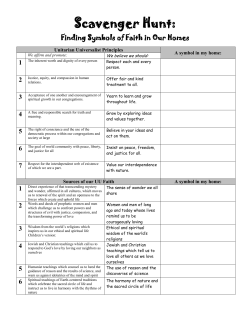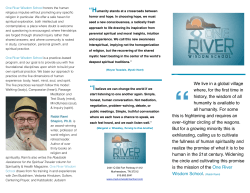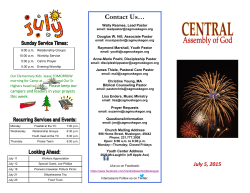
Church Board Renewal Retreat
Chicago Central District Delivered by Mission Area Church Board Renewal Retreat Our Goal: To build agenda harmony with every Nazarene attender, church member and all church leaders, building and shaping the future of our church together toward a clear vision and a clear set of priorities, initiatives and goals. A. Bible Promises about Agenda Harmony (Ephesians 3:10, 5:25-27) 1. David – Psalm 133:1,3 2. Definition – Agenda: “an outline or plan of the things that must be done” Harmony: “a unified arrangement of parts with a common focus” 3. Jesus – John 17:21,23 (Acts 2:1 – the anointing of unity) 4. Paul – Philippians 2:1-2 (1 Chronicles 28:19 – God’s hand on us!) “Our plan is to walk everyone through a process of participation that will assist us to define current reality in our church, affirm and perfect our Vision, Initiatives and Goals, bringing our church together so the spirit of Pentecost reoccurs among us. 8 Desired Outcomes For Our Thinking & Planning: 1. Seek wisdom from God and the agenda of Jesus as we proceed 2. Discuss and focus our thinking on the church’s future direction 3. Clearly understand the power and value of agenda harmony 4. Get better acquainted with each other 5. Confirm a spiritual planning process and tools we can use 6. Identify strengths and weaknesses of our church that need improvement 7. Determine our potential key initiatives for the coming months 8. Set some measurable, key goals 1 • Right now, what are you thinking about your Church? What Is God Thinking? • • Our greatest need…is NOT to know what we're thinking, but what God is thinking! (1 Corinthians 2:9-13,16) All of our strategic thinking and planning for our church must be grounded in the spiritual realm. Basic Principles on God's Thoughts…God's Vision 1. We have the Holy Spirit 2. The Holy Spirit knows God's thoughts. 3. We can know what God is thinking, especially His vision for us! 4. God is more anxious to reveal His vision, than we are to seek it! 5. Agenda harmony is foundational to spiritual anointing (Psalm 133:1,3) 6. Jesus taught the value of agenda harmony (John 17:21,23) 7. Churches that are anointed have prayer/unity foundations (Acts 2:1) 8. A key to achieving God’s vision is to seek it and affirm it with godly leaders and other believers in the church. 9. Another key to achieving God’s vision is to pray together (Acts 2:1) and gain agenda harmony within the church on the direction God wants us to follow. 10. When multiple agendas are present, the anointing of God will always be absent. When agenda harmony is achieved, the church is unstoppable! Scriptures You Can Pray Back to God… A. "We should make plans, counting on God to direct us." Solomon -- Proverbs 16:9 B. “Any enterprise is built by wise planning, becomes strong through common sense, and profits wonderfully by keeping abreast of the facts.” Solomon – Proverbs 24:3-4, TLB C. "For I know the plans I have for you," declares the Lord, "plans to prosper you...plans to give you hope and a future." God -- Jeremiah 29:11 D. "Then the Lord said, “Write down the vision and make it plain on tablets so that those who read it may run with it. For the vision awaits an appointed time...Though it linger, wait for it; it will certainly come and will not delay...but the righteous will live by faith." God -- Habakkuk 2:2-3 (1 Chr 28:19) E. “Where there is clear vision, people do not perish.” Solomon - Proverbs 29:18 2 “’All this,’ David said, “I have in writing from the hand of the Lord upon me, and he gave me understanding in all the details of the plan.” (1 Chronicles 28:19) Exercise #1: Seeking Godly Wisdom Spend some minutes around the table, praying specifically for the following items. 1) that God’s agenda and vision will become clear to us, 2) for a “team” agenda rather than individual agendas and visions to dominate, 3) for the kingdom of God to come and His will be done among us…, 4) for GREAT wisdom the pastor, the board and other leaders as we build the church’s future together, 5) wisdom for all of the people involved in leading today, 6) thanking God for His promise in James 1:5-8, a promise for His wisdom as we seek “the mind of Christ.” (1 Corinthians 2:16) The secret to finding the right answer is to ask the right question! “After three days they found him in the temple courts, sitting among the teachers, listening to them and asking them questions. 47 Everyone who heard him was amazed at his understanding and his answers.” (Luke 2:46-47) Key Questions In Building A Spiritual Plan 1. Who are we? What do we value? MISSION & VALUES 2. Where are we? NEEDS 3. Where does God want us to go? VISION & PRIORITIES 4. How are we going to get there? GOALS & PLANNING 5. When will it be done? SCHEDULING 6. Who is responsible for what? DELEGATING 7. How much will it cost? BUDGETING 8. Did we do it? EVALUATING 3 1. Who are we? Who are we? Why are we here? Why does our Church exist? Defining our Mission: • A mission is a broad, brief statement of what our church is supposed to be doing. • It should be short enough to be learned and put on a T-shirt. (we suggest keeping it to no more than 7-8 words. • The words are important but the process is more important. Key factors are clarity & participation. • Helpful Questions: What is our church’s purpose and reason for being? Why does our church exist? What will make its work and role valuable? What will make people feel that they cannot do without our church? • Two Versions: The longer one may be more descriptive and complete. The shorter one is the one that matters most. Popularize it in 5-8 words, memorize it and refer to it often! Exercise #2: Our Mission Discuss: Who are we? Why are we here? Why does our church exist? How does it relate to the Great Commission and Great Commandment of Jesus? Is our mission already “learned” by the congregation? By our leaders? (Matthew 22:36-40; 28:18-20) Individual: Take a few minutes and each person write out what a beginning “learnable” mission statement for our church. How can we make the longer one we have “learnable?” Discuss: Discuss & together create a mission statement that could/will guide future decision making as a church. Select a Recorder, whose responsibility will be to record a summary of our work today. Next Action Steps: After this planning day is over, what action steps should we take as leaders related to the development or communication of our mission? These steps will impact the development of both our Board and our Church Action Plan. 1. What do we value? Church Values: What Do We Value Assumed Values Actual Values 4 How We Can Determine Our Current Values: • By examining the following 4 things: a. Our calendar b. Our checkbook c. Our decisions (board minutes & staff decisions) d. Our conversation (what we talk about) Exercise #3: Church Core Values Key Questions: What do we value? What would we like our church to be known for? What stirs us emotionally and causes us to act? (or should?) Discuss: Take a few minutes and discuss the three questions above. (This is based on what you know of your calendar, your expenditures, your staff and board decisions and the conversations you engage in). Make a list of 4-5 core values that you believe should guide our church behavior. Recorder, gather and record this core value list for future use. Next Action Steps: After this day is over, what action steps should we take as leaders related to developing our core values? These will shape the development of our future greatly. Having a clear mission and a clear focus is the foundation and the beginning of GREAT Spiritual Plan. 2. Where are we? SWOT Analysis Strengths Opportunities Weaknesses Threats (Challenges) We presuppose Christian attitudes among all of us at this kind of Gathering. (1 Corinthians 11:17; 1:10) Spirit of Doing S.W.O.T. (John 8:32; Ephesians 4:15, 1 Peter 4:8) 5 Exercise #4: S.W.O.T. Analysis Individual: Take a few minutes and make a list of 3 strengths our church has. Take another few minutes as individuals and on a separate sheet of paper, make a list of 3 weaknesses or areas in which our church needs to improve. Discuss: After discussing the results, together create a summary list of 3 strengths and 3 weaknesses of our church. The Recorder should capture a summary of everyone’s strengths and weaknesses to include in the strategic Action Plan document. Individual: Take a few minutes and make a list of what you believe are the 3 biggest needs (opportunities) our church has facing its future. Discuss: After discussion, together create a summary list of the 3 biggest needs and opportunities we need to focus on as an church. (Keep open to the Holy Spirit today, He may want to adjust our focus as we proceed!) Recorder, capture a summary of these 3 biggest needs and opportunities we currently face. Next Action Steps: After our time together is over, what action steps should we take as leaders related to addressing these key needs & opportunities we face? These steps will add to the development of our future and Church Action Plan. #3. Where do we believe God wants us to go? (Philippians 1:9) • Developing the Church Vision: Where is God leading us? What should our future be? What do we do that makes us indispensable to the community God has placed around us and called us to serve and impact? • Your Church…5-10 Years From Now: Biblical Instruction (Habakkuk 2:2-3), write the vision down, make it plain to read. It should describe where we are going. It should describe what our church will look like 5-10 years from now. It should develop a mental image and picture that motivates people. Sees a healthy church and all of its various departments functioning in a healthy way. A shared vision sees the future taking place, before it begins happening (Romans 4:17; Hebrews 11:1,6). • This requires not only a clear vision, but also clear priorities. We can’t do everything immediately because we have limited time, people and finances. So we must select. We can do the right thing…and the wrong time…and hurt the church’s development. “There is a time for everything and a season for every activity…” (Ecclesiastes 3:1). What are the most important areas we should focus on in the coming days? 6 Answering the first 3 questions on page 4 is the hardest part of strategic thinking and planning. Once we get the foundation laid, the rest of the questions (#4 - #8) are much easier! Goals must be connected to our vision and our core values. Goals must move us toward becoming a healthy not-for-profit organization. S.M.A.R.T. & Good Goals S pecific M easurable A ction focused R ealistic T ime constrained Achieving goals in the future require priorities. Once our priorities are clear, the goals become much easier! #4. How are we going to get there? Goal Setting Exercise (to be used by our Church Board) 1. Pick one priority and/or core value we have embraced as an organization. 2. What do we want people to do differently that we are currently doing? 3. Determine the goal that would help strengthen our Church. Action Plan – Goal Worksheet The sheet on page m is used to show the relationship between specific tasks that must be accomplished and the people who are involved. It’s particularly helpful when: • A goal’s achievement that has been decided on, is seen in a series of steps. • You want to clarify accountability for these steps or tasks to be carried out. • Deadlines are important to pay attention to. The role of the pastor is to monitor the progress of the plan and serve as a cheerleader for its accomplishment. 7 • This tool is designed to answer questions 4-8 in the Strategic Thinking & Planning process. • Using the Action Plan – Goals Worksheet puts down in black and white who is accountable for which steps and by what date. Steps To Follow: The Action Plan steps are usually developed after an individual or group has agreed, set a goal and sees the action that must be taken to reach it. The next steps are these: • State the goal in writing. • Determine who is responsible for the goal’s achievement • Answer the question: How will we reach this goal? • Clarify accountabilities and get final agreement from team members. • Make sure to involve those who will be responsible for implementing the plan in this part of the process. • Make sure the plan makes sense and is action focused. #5. When will it happen? Understanding the difference between long term goals and short term goals Achieving goals always involves taking little steps. Develop and communicate a realistic Timeline: • A well-thought out timeline will help add credibility to your plan. • A well-thought out timeline will build accountability into your plan. • When church is linked with other visible ministries, churches, etc. it is very important that linkage is thought through fully and that the people in the church who are impacted by our church see the value and feel the benefits of our church’s ministry activities as it begins. • “People will always be down on what they are not “up” on.” #6. Who is responsible for what? 1. Use the Action Plan – Goals Worksheet 8 2. Determine who will be responsible for the completion of the goal 3. Determine who will be responsible for each action step #7. How much will it cost? Determine the budget needed for the accomplishment of each goal. Build the budget, so that the budget is driven by the Mission, Vision, Core Values and is connected to the Action Plan priorities we have agreed to. #8. Did we do it? Organize the overall strategic plan into smaller action plans assigned to different teams. Make sure the first 3 – 6 months are completed in detail. Build in reviews and accountability. The role of the pastor and others delegated to…is to communicate to the leaders that the plan and action steps will be reviewed on a regular basis. Distribute the plan and refers to it often! Be sure that there is one person or team that has ultimate responsibility for carrying out each goal connected to the Action Plan. The pastor, staff and volunteers are the cheerleaders and encouragers to make sure the plan is followed. Key “ambassadors” may also be a developed for each one of the church departments, ministries under development, expansion, etc. Gather feedback often from those executing the plan and always be looking for ways to improve not only the plan, but the “culture” of our Church and daily operations. Assign action steps to teams of two people and have each commit to helping the others finish the action step. Have regular meetings where you review, review and then review again. These quarterly scheduled meetings of our Church Board and/or the staff and ministry leaders of our church are the ones the Board will delegate responsibility to and maintain accountability with. 9 ACTION PLAN – GOALS WORKSHEET Goal # __: Responsible Person: How will we reach this goal? # Action Plan Step By Whom By When Cost Done 1. 2. 3. 4. 5. 6. 7. 8. 9. 10. 11. 12. 10
© Copyright 2025





















